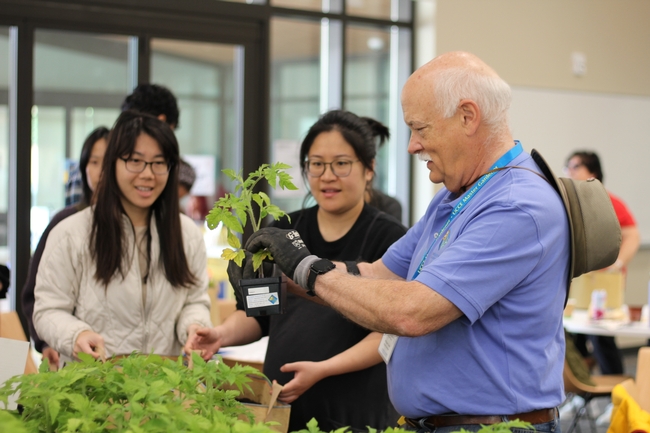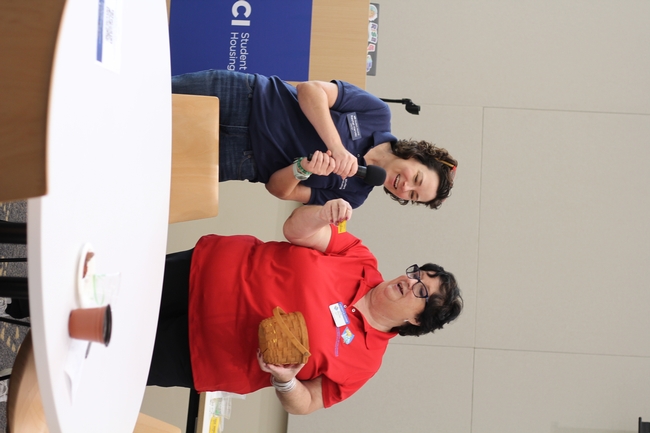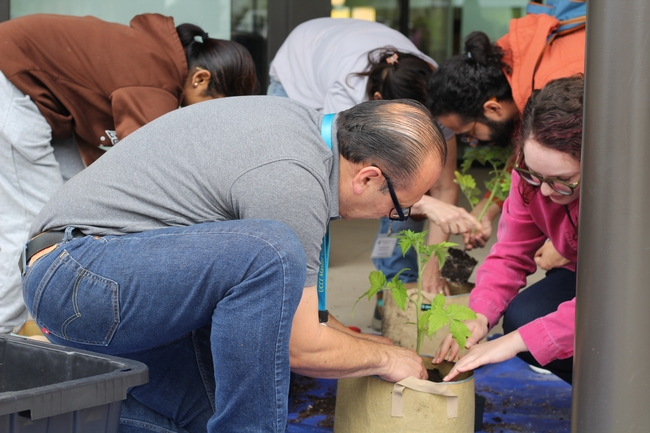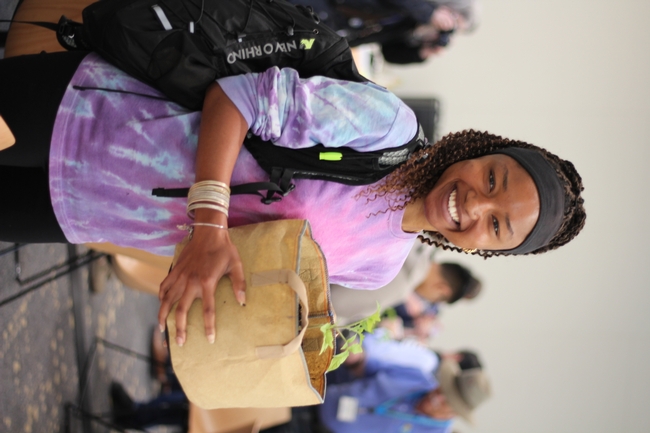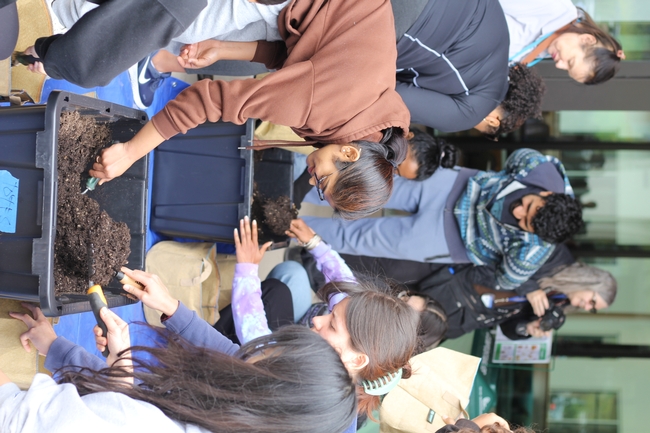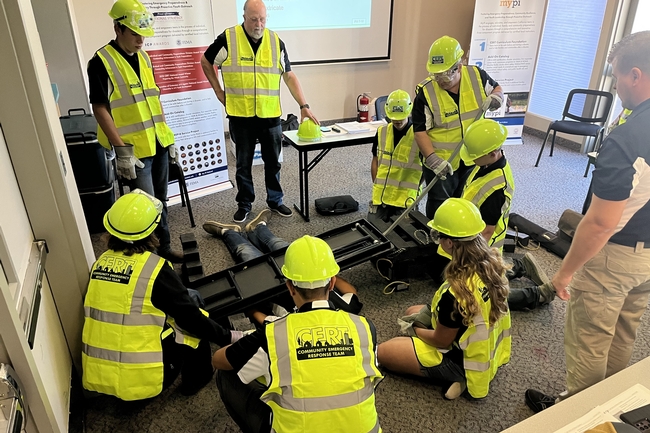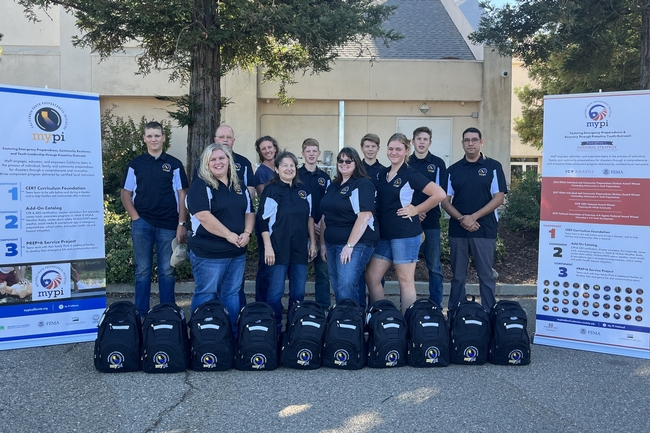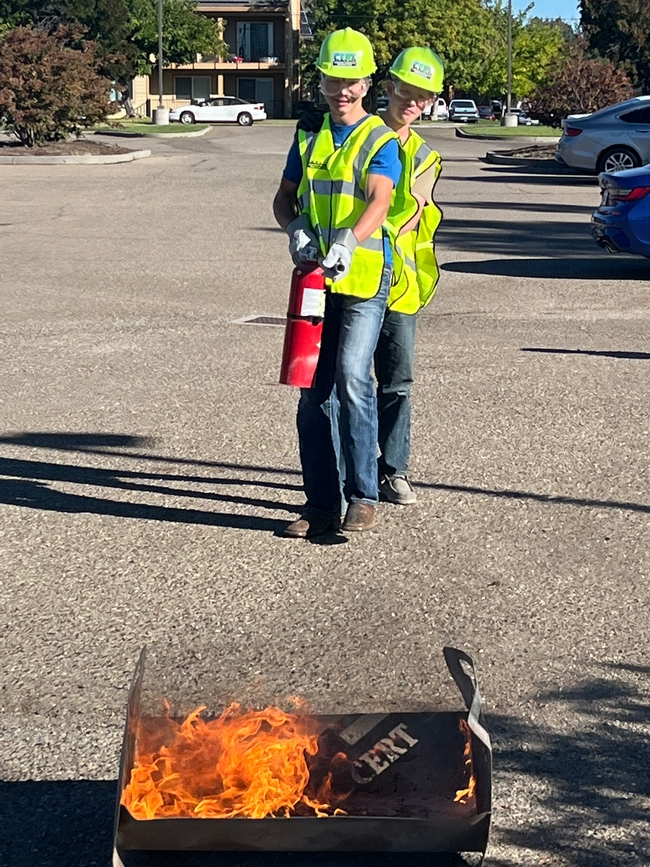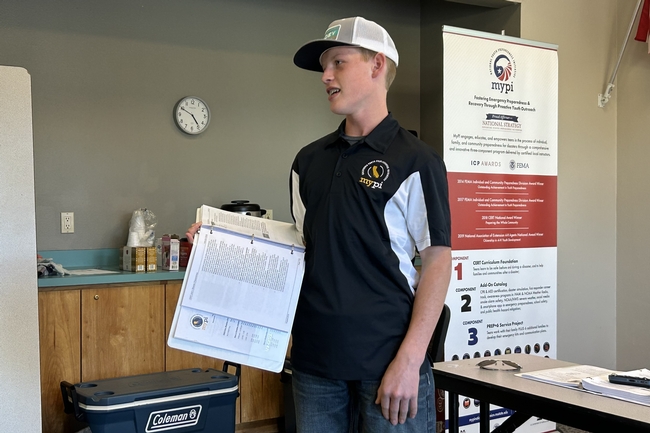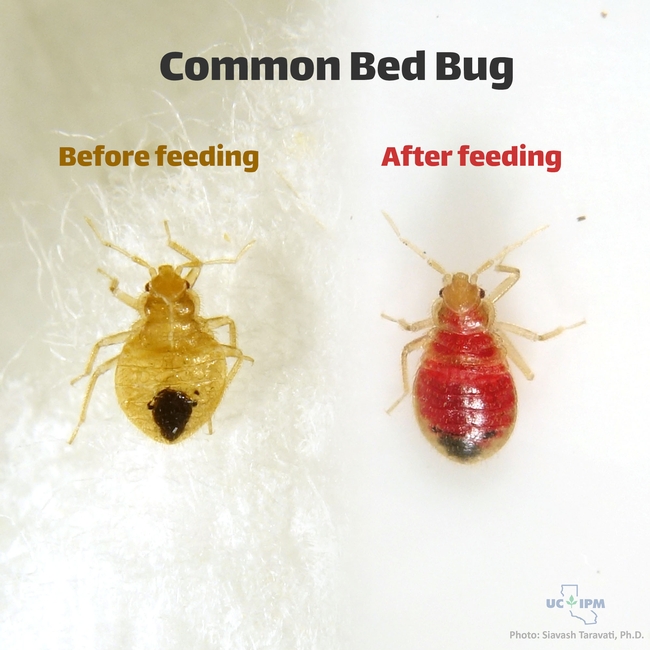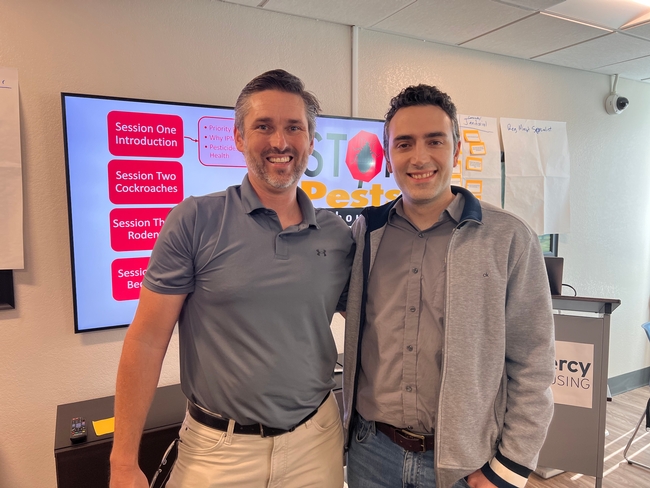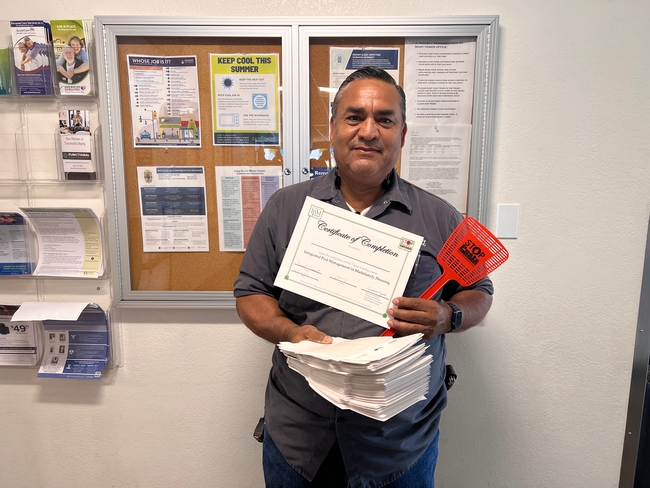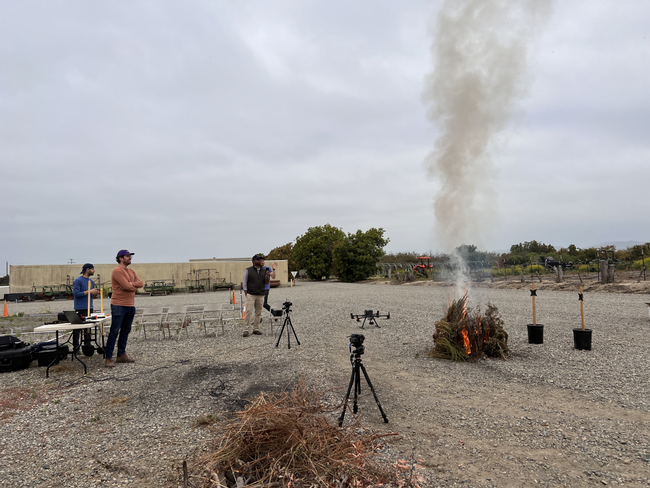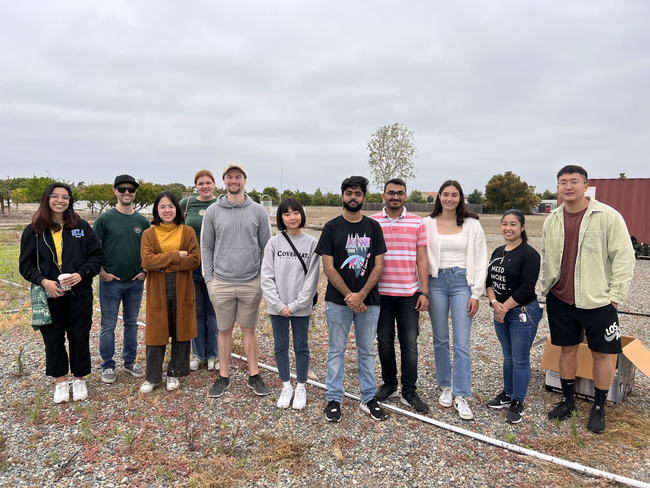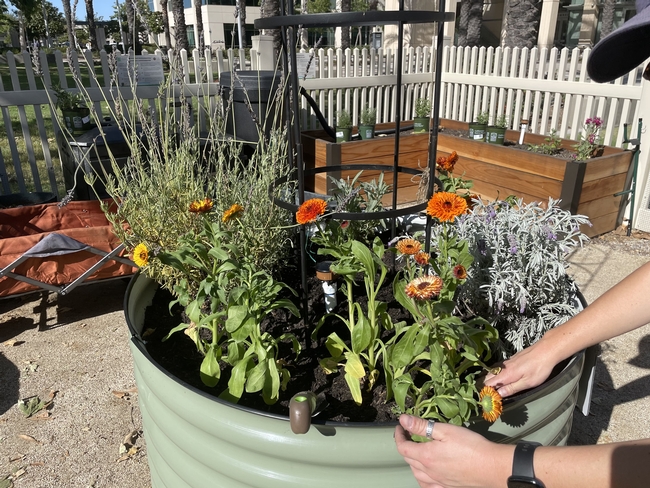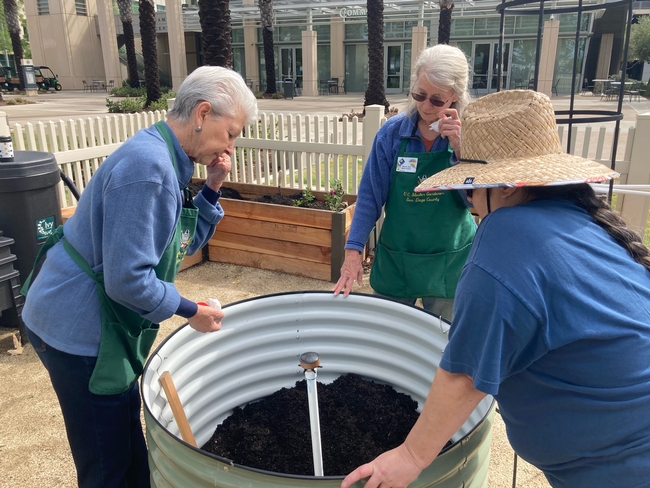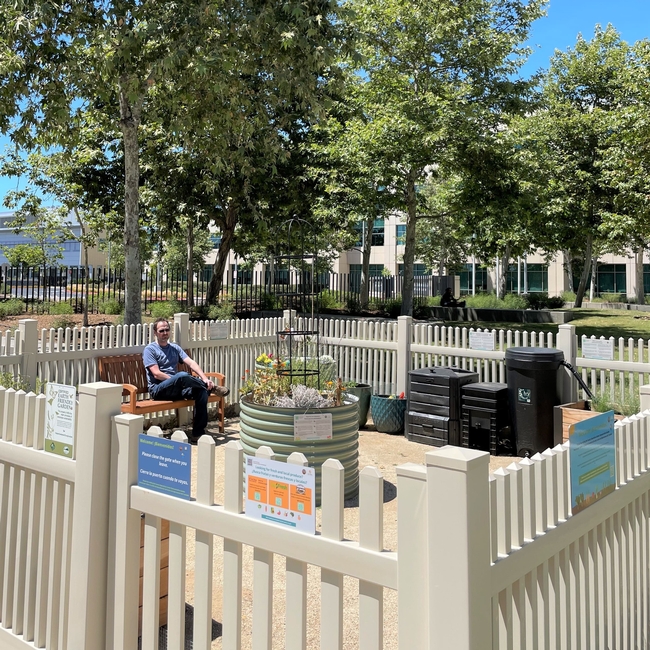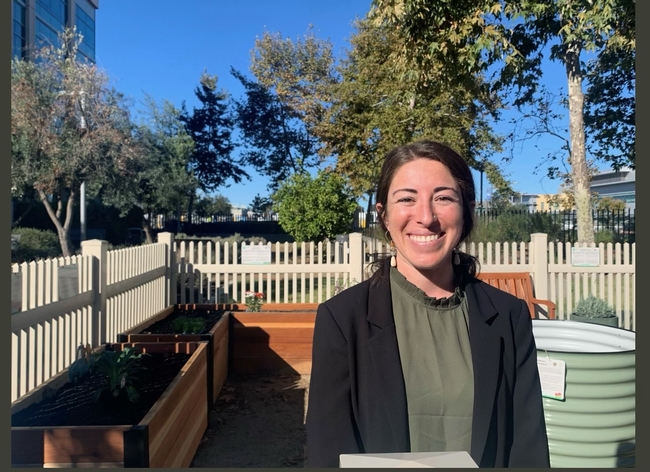- Author: Saoimanu Sope
Although training is required to become a University of California Master Gardener, the benefits of gardening can be experienced by anyone and everyone.
“As long as you're willing to get your hands dirty,” said Laurie Menosky, a UC Master Gardener volunteer in Orange County, “you can learn to grow all sorts of things.”
In early April, Menosky partnered with ETN Medical Infusion (a clinic in Orange County) and the Sustainability Program for Student Housing at UC Irvine to teach students how to grow tomatoes. Menosky welcomed all in attendance, including families with toddlers who seemed fascinated by the 60 tomato plants atop one of the tables in the room.
The UC Master Gardener Program is a part of UC Agriculture and Natural Resources. During her presentation, Menosky taught participants how to choose varieties that fit their taste and growing environment, how to cultivate a thriving environment, and how to control pests and diseases using integrated pest management practices.
“We have 16,000 residents at UCI and sustainability is one of our values. One of the ways we engage students is through on-campus gardens,” said Rachel Harvey, sustainability program manager for UCI Student Housing and a UC Master Gardener volunteer in Orange County.
UC Irvine has one teaching garden reserved for undergraduate learning, and three gardens operated and maintained by graduate students. “I was on the waiting list for a garden plot for a while, but it was totally worth the wait,” said Johanna Rinaman, a fifth-year Ph.D. student studying physical chemistry.
While the highlight of the event for many people was the opportunity to take a tomato plant home, another important takeaway was how gardening can be a good activity for your mental health. Sarah Nghiem, family medicine specialist at ETN Medical Infusion, who worked closely with Menosky, was instrumental in developing the mental health content for the day, encouraging attendees to attempt gardening with a mental health perspective.
Nghiem and her team received funding from the Orange County Health Care Agency through the Mental Health Services Act to work with transitional aged students (15-24 years-old) on understanding the importance of mental health, which led to the collaboration between UC Irvine, her alma mater, and the UC Master Gardeners of Orange County.
“I didn't do any gardening during the winter, and I felt a lot more anxious and depressed during that time,” Rinaman said. “I know gardening improves mental health because I've immediately felt a difference whenever I spend time with plants.”
Rinaman, whose father taught her a lot of what she knows about gardening, said that having access to a 4 feet by 6 feet plot to grow her own food is one of the many things she loves about UC Irvine.
Like Rinaman, Menosky turns to gardening to decompress, especially during the long days of summer. Teaching others about the physical and mental benefits of gardening gives her an opportunity to share her experience and, hopefully, help others find new ways to manage stress.
“We often have attendees come back years later telling us how our information has helped them and how much more they are enjoying their time in their gardens,” she said.
To conclude her presentation, Menosky instructed participants to line up for their own tomato plant. Attendees took their plants outside to transfer them from a small pot to a grow bag – a type of container that helps root structure development.
Cassie Ekwego, a third-year transfer student studying civil engineering, couldn't hide her excitement after carefully lifting her plant. “I don't think I realized how attentive you need to be when working with plants,” said Ekwego, reflecting on what she learned from Menosky's presentation.
Now that she has her own plant to care for in her own home, Ekwego is eager to put her new knowledge to the test. “I love tomatoes, but this is going to be a huge responsibility for me,” she said.
Randy Musser, UC Master Gardener program coordinator for Orange County, said that while he enjoys talking to avid gardeners, bringing gardening to new people in the community is special to him. “This tomato workshop is particularly exciting for me because it is an opportunity for the UC Master Gardeners to grow our connection to UCI and young people just starting off on their gardening journey,” said Musser.
With a generous contribution from UC Master Gardener volunteer Sheila Peterson, Musser was able to purchase enough supplies to help attendees, like Ekwego, jumpstart their gardening experience.
Students, whose stress levels can skyrocket throughout the school year, value opportunities to be outdoors, try something new and be in community. “The garden is a different type of classroom. It's a place where students can learn and experiment, hopefully in a way that reduces stress,” said Harvey of UCI Student Housing.
Ekwego, who tried gardening for the first time while volunteering at UC Irvine's teaching garden, is just one of the many students inspired by their experiences. “Gardening reminds me that it's OK to get my hands dirty,” Ekwego said.
- Author: Michael Hsu
4-H leaders, youth complete state's first MyPI instructor certification workshop in Tehama County
Disasters do not discriminate. They can impact people regardless of their race, color, creed, socioeconomic status – or age. That's why a nationwide effort to train young people in emergency preparedness continues to grow and is establishing itself in California.
The national MyPI (Preparedness Initiative) program, developed by Mississippi State University Extension, partnered with California 4-H this fall to train the state's first cohort of instructors, who will then lead trainings for young people in the coming months. With Northern California as the catalyst, organizers plan to spread the program across the state, said Nate Caeton, 4-H youth development advisor for Shasta, Tehama and Trinity counties.
“If you look at the research, everybody is affected by disasters, but young people even more so, for a number of reasons – whether because they don't fully understand what's going on, or they don't have the same experience or skill sets as adults,” said Caeton, who serves as the MyPI California manager. “But this takes a huge leap in addressing that.”
California is the 28th state/territory-level program to partner with the national MyPI team to train instructors – but the first to allow young people to participate in the three-day instructor workshop.
Of the 11 4-H-affiliated participants who completed the October training in Red Bluff, five were teenagers. The workshop, led by national MyPI trainers, included comprehensive Community Emergency Response Team (CERT) content developed by the Federal Emergency Management Agency, known as FEMA – covering medical operations, fire safety, light search and rescue, disaster psychology and more.
“By the end of day 1, the trainers were already commenting on the maturity level of the teens who had attended,” Caeton said. “They've been doing this training for a long time and they were definitely impressed – that says a lot about our young people.”
Potential disasters necessitate preparation by all
Bodie, a ninth grader in Shasta County, said the MyPI California workshop gave him a new perspective on his father's role and responsibilities as a CAL FIRE battalion chief.
“It was a great class, a great experience,” said Bodie, who participated in the training with his two brothers. “It was a 30-hour-long class – really long, but really fun; there was a lot of hands-on learning.”
Katy Zulliger, Bodie's mother, also attained instructor certification through the workshop. She said that, in their city of Redding and communities across the region, there remains considerable trauma from the devastating fires of 2018 – the Carr Fire and Camp Fire. Zulliger said that educating and preparing the public – including youth – will be crucial in meeting future challenges.
“There's a lot that can happen around here – from earthquakes to fire to flood to mudslides, and the list goes on and on…even, living on I-5, potentially tanker trucks spilling over,” she explained. “It's smart for the kids to learn how to think outside the box.”
Bodie noted that the workshop has made him more aware of his surroundings and potential contingency plans.
“When I'm out in the town, I really do think about what can happen in different scenarios – for example, maybe an earthquake or active shooter situation – and I ask myself, ‘What would I do? How would I respond?'” said Bodie, who is considering a career as a first responder.
Youth have a voice, role in boosting community resilience
The skills and knowledge gained from the MyPI program can equip young people to be leaders among their peers, and even in the broader community, when emergencies arise.
“Kids can actually use this and be engaged – instead of just being a watcher or video taker,” said Zulliger, a 4-H volunteer who has served as a club leader of the Palo Cedro 4-H club. “They have a voice and they can use it positively.”
Her sons – and the other two teens who completed the workshop – will help adult instructors organize and deliver the 10- to 12-week MyPI training to young people in their communities. As part of the program, tentatively slated to begin in Northern California by summer 2024, youth participants will be required to work with their families to create an emergency communications plan, assemble a disaster kit, and reach out to six other households to make similar preparations.
“This gives them some ownership over their own personal preparedness and the preparedness of their family and those they are closest to,” Caeton explained.
By partnering with schools, 4-H clubs and community groups, Caeton said the goal is to deliver the program to 125 young people, across five Northern California counties, by summer 2025 – before expanding participation across the state.
“I'm hoping it spreads like wildflowers, because it's definitely needed,” Zulliger said.
- Author: Saoimanu Sope
Living with pests, or “unwanted guests” as some put it, can take a physical, mental and economic toll. For people living in multi-family unit housing, like an apartment complex where everyone lives under one roof, a single infestation of insects or rodents can expose all residents.
Using integrated pest management, or IPM, residents and property managers can detect infestations early and control severe ones and protect people. IPM programs can also save money. IPM saved a 75-unit complex in Contra Costa County $11,121 annually. Similarly, in Santa Clara County, a 59-unit complex saved $1,321 on pest control annually after implementing a proactive IPM program.
This summer, regional directors, property managers, residential service coordinators, maintenance managers and groundskeepers of Mercy Housing – a nonprofit organization that provides affordable, low-income housing – gathered in Long Beach to learn about in-home IPM. The session was led by Siavash Taravati, University of California Cooperative Extension area IPM advisor for Los Angeles, Orange, Riverside and San Bernardino Counties, and
Josh Shoemaker, an entomologist and private consultant.
Taravati and Shoemaker collaborated with StopPests in Housing, a national program out of Cornell University's Northeastern IPM Center, which seeks to improve pest control in affordable housing and teach management practices for cockroaches, bed bugs and rodents within and around the home.
During their presentation, Taravati introduced participants to the IPM principles and emphasized the importance of monitoring pests.
“IPM is all about making informed decisions which requires knowing the latest status of an infestation,” explained Taravati. “That's where monitoring comes into play. It can help us to identify the exact species we are dealing with as well as telling us if an infestation is growing or shrinking.”
“Monitoring is foundational,” agreed Shoemaker. “If a program does not include monitoring, it's not an IPM program.”
According to Shoemaker, the benefit of partnering with UC IPM is their sharp focus on general IPM, which includes monitoring. “It's real IPM, that prioritizes the well-being of the public,” said Shoemaker, who's eager to continue working with Cooperative Extension and Taravati to ensure that children are growing up in safe environments.
Pest control treatments commonly take place following a serious infestation or several complaints, but IPM promotes constant monitoring to prevent heavy infestations from ever happening. It's a proactive approach rather than a reactive or emergency-response. For many attendees, the training revealed a need to engage with pest management operators more closely.
Training prompts changes that improve safety for residents
Pest management operators commonly use pesticide sprays to control pests. Besides inconveniencing residents, forcing them to do extensive preparations and evacuate their unit until it's safe to return, sprays increase exposure risk to pesticides since the aerosols can linger and land on surfaces.
Instead, Taravati and Shoemaker recommend using gel baits, which are much safer to apply and can target a specific area of a home, including crevices, instead of along all the walls.
“Now that I'm more informed, I'll be speaking to my contractor to discuss how we can switch their approach from a bug spray to a gel,” said Leonardo Pinuelas, a maintenance manager for Mercy Housing.
Pinuelas is not the only one wanting to modify their program, however. According to feedback from staff members at the Housing Authority of the City of Los Angeles who experienced the same training earlier this year, they prompted their team to amend their pest extermination to include dusting, or applying insecticidal dusts, against roaches, and to review and update their existing IPM plan and practices where appropriate.
Cindy Wise, area director of operations for Mercy Housing, said that in her 35 years, this was one of the few trainings that engaged her staff so actively. “I couldn't help but text my regional vice president to say that our managers were actively participating and asking questions. That doesn't happen often, not even in our own meetings,” said Wise.
Many of the attendees, with their new understanding of how cockroaches move through a structure, shared that they are eager to return to work to meet with residents and support them.
“If you've got roaches in one unit, you've got them in the entire building,” Wise said.
Shoemaker recalls the words of Judy Black, senior technical entomologist for Orkin, and Dini Miller, entomologist at Virginia Tech, who urge the importance of inspections and documentation as IPM best practices.
Although reporting pests in the home can make one feel embarrassed, Wise said she is more interested in making residents feel empowered to not only report signs of infestation to the staff, but to their neighbors.
Training residents is certainly beneficial, but as experts such as Black and Miller have pointed out, housing managers must do their part, instead of scapegoating tenants for their cleaning habits.
StopPests provides free IPM training and technical assistance to Housing and Urban Development assisted properties. If you are interested in the training provided by Taravati and Shoemaker, in collaboration with StopPests, visit StopPests.org for more information.
- Author: Saoimanu Sope
Besides starting fires for the sake of research, Luca Carmignani, UC Cooperative Extension fire advisor for San Diego, Orange, Los Angeles, and Riverside counties, has started leveraging his connection to local UC campuses by providing opportunities for hands-on learning.
Early one morning in May, students and staff from UC Irvine and UC Riverside gathered at the South Coast Research and Extension Center to collect data for their own research projects. South Coast REC, located in Irvine, is part of a statewide network of research and education facilities operated by UC Agriculture and Natural Resources.
In one area of the field, graduate students picked leaves and twigs from dried shrubs, carefully placing them in a device that measures moisture content. In another area, a postdoctoral scholar set up a device that records levels of particulate matter, carbon dioxide and other air pollutants emitted by a fire.
Tirtha Banerjee, professor in the Department of Civil and Environmental Engineering at UC Irvine, coordinated the field day with Carmignani. The two first connected as members of iFireNet, an international network of networks that connect people to fire research, when Carmignani was a postdoctoral researcher at UC Berkeley.
Now, the two are collaborating to help environmental science and engineering students realize the potential of their research interests.
Jacquelynn Nguyen, a Ph.D. student in the Civil and Environmental Engineering department at UC Irvine, is interested in understanding how ash from wildfires and prescribed burns can be used as a treatment for per- and polyfluorinated substances. PFAS are a group of “forever chemicals” that can be found in heat-resistant materials – including fire extinguisher foam – and are extremely difficult to eliminate.
Before Nguyen could collect her ash samples, Carmignani needed to cautiously set the dried shrubs on fire, providing a realistic situation for data collection purposes.
“We're trying to figure out if the ashes from these fires can be used as activated carbon, which could be used as a treatment for PFAS,” said Nguyen. “We want to see if this treatment can basically absorb PFAS and prevent it from traveling into soil and groundwater.”
While Nguyen is concerned about the impact that wildfires have on the land, Soroush Neyestani, a postdoctoral scholar in the Environmental Sciences department at UC Riverside, is interested in its impact on the air quality.
During a fire, it's difficult to determine how much emissions are a result of flames versus smoldering, the process of burning slowly with smoke but no flames, and current air quality models do not provide accurate guidance on this matter. Using an air quality sensor, Neyestani wants to quantify the difference in emission levels during the two phases.
“There are assumptions that 50% of emissions come from smoldering, but every fire is different. Our main objective is to improve the accuracy of air-quality forecasting,” Neyestani said, noting his concern that these assumptions might not be realistic.
Although the field day was created with the students in mind, Carmignani used the opportunity to polish his own research efforts. Since fall 2022, he has been investigating the flammability of low-water use landscape plants based on various irrigation applications.
“Every time we burn, I feel like we get better. We get better data, and we conduct better analysis, and that's really important for us so that we can figure out how we can apply our research and measure its outcome,” said Carmignani.
In addition to welcoming more collaborations with UC campuses and other organizations, Carmignani is hopeful that these combined research efforts will spark an interest in wildfire awareness everywhere.
- Author: Mike Hsu
Master Gardener volunteers partner with County of San Diego on new demonstration garden
In a garden with roughly the square footage of a two-car garage, the University of California Master Gardeners and County of San Diego staff have packed a whole lot of learning for the community.
The demonstration garden, which had its grand opening last fall, is now flourishing in its 20-by-20-foot space in a plaza at the heart of the San Diego County Operations Center. Skilled volunteers with San Diego's UC Master Gardeners, a program of UC Agriculture and Natural Resources, maintain its containers of vegetables and herbs, succulents, and native and pollinator plants.
“For such a little garden, there's a lot to look at,” said Karen Morse, a Master Gardener volunteer who helped establish the “demo garden” – a highly visible and accessible teaching tool for the many people who work and conduct business in the surrounding offices.
“We get questions from people just walking by – from the public, from county employees – all the time,” said Leah Taylor, UC Master Gardener program coordinator in San Diego County. “While we're doing what we're doing in the garden, we're a presence for people to just get a quick bite of education.”
The garden also features a “Little Free Library” of gardening books, as well as a compost bin and rain barrel for demonstration purposes. There are also signs (in English and Spanish, as well as additional languages on the garden's website) offering tips on composting/worm composting, pest management, water conservation, climate adaptation, sustainability practices, and health and nutrition. The expertise of a host of county departments and agencies inform the resources.
“The most beautiful thing about that garden is not necessarily the plants – although we love our plants – it's that it showcases almost every county department…all represented in one place and you can find how to connect with those groups, all in one place,” Taylor explained.
During planning for a broader revamp of the Operations Center grounds, the county had approached the Master Gardeners to provide guidance on a public demo garden.
“The County has a long-standing commitment to sustainability and partnership with the University of California Cooperative Extension,” said Rebeca Appel, program manager for the county's Land Use and Environment Group, which spearheaded the effort through the “Live Well San Diego” Food System Initiative. “So it was a natural approach to work with the Master Gardeners with their robust community garden program, and educational outreach in home and urban gardening throughout our region.”
The vision for the garden was shaped by county teams working with Joan Martin and Ellen Cadwallader, co-chairs of the Master Gardener committee that oversees the program's demonstration gardens across San Diego County, including those at Balboa Park and The Flower Fields in Carlsbad.
And while those gardens help raise awareness among the many visitors at those sites, Martin said the newest demo garden provides unique opportunities for ongoing community education, such as lunch-and-learns on specific gardening topics.
“This is the garden where there's really a chance for year-round education and sessions,” Martin said. “We're excited to see it get started and watch it grow.”
Morse and fellow Master Gardener Sandy Main collaborated with Appel to bring those early plans and objectives to verdant life.
“I think we ticked all the boxes of everything they wanted, initially – examples of container gardening, natives, vegetables, herbs, pollinators – and wheelchair accessible,” Morse said.
They have since passed the botanical baton to Skye Resendes, a relatively recent graduate of the Master Gardener certification program. She will coordinate a team of a dozen volunteers in the ongoing upkeep of the County Operations Center demo garden.
Resendes, who uses gardening to help her cope with the stresses of her work as a civil litigator, said she hopes the garden will not only inform the community on crucial ecological and conservation topics but also inspire more people to start their own gardens.
“The science is out there – there are huge mental health benefits to gardening,” Resendes said. “It's an absolute meditation.”

